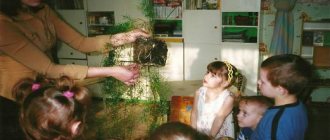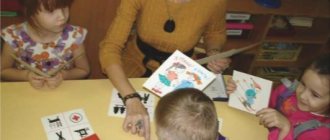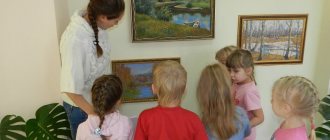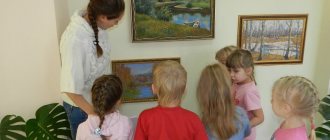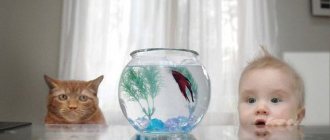The perception of beauty increasingly comes down to the price of an artistic masterpiece at auction. Assessing the “prestige” of beauty displaces true aesthetic values and prevents us from perceiving beauty as the highest measure of humanity and a component of morality. Is it possible to cultivate taste in children and adults or is this the prerogative of only “refined” natures? How relevant is aesthetic education today, and how can it be organized correctly? We will look for answers to these complex questions in our article.
What is aesthetic education
Aesthetic education in pedagogy is understood as a purposeful influence on the formation of human personality. At the same time, the choice of means of such influence is huge, starting from a work of classical art and ending with the natural beauty of nature. It is necessary to instill the skills of self-knowledge and self-improvement through the prism of beauty from early childhood.
Parents, concerned about the future of their baby, begin raising him from birth. Beautiful bright toys, classical music, affectionate faces of parents - these are the main components of the educational process. Harmony and beauty in things, words, and actions allows a little person to see, feel and appreciate beauty.
“Correct” life guidelines are “picked up” by kindergartens and schools. In educational institutions, they deepen moral concepts through the prism of beauty and kindness, and teach, using the examples of literary heroes, to choose the right path in life. With the help of paintings, he learns to dream and then make dreams come true. In labor arts lessons, learn the science of beautiful “dirty” hands and the ability to create masterpieces in everyday life.
However, in practice, the path of aesthetic education is thorny and complicated. Often its incorrect construction or complete absence is associated with the illiteracy of adults who themselves, without a clear understanding of it, cannot convey the value of the beauty of the world around them.
Proper education of taste involves learning the ability to perceive beauty in all its manifestations: in art, work, feelings. It is important to instill feelings and tastes, the need to take part not only in the creation of beauty, but also in its creation.
A common thread in aesthetic education should be the idea of the need to translate beauty into everyday life through examples and examples of art. You cannot admire the beauty of classical music, enjoying listening to it, and use foul language when you go outside the theater. The ability to appreciate “samples” of art allows you to transfer beauty into everyday things: everyday life, work, family.
The close relationship between aesthetics in everyday life is actively manifested in everything. Creativity shapes memory, intelligence, and the ability to plan. The opportunity to appreciate the beauty of nature - patriotism, love for the small homeland. Complex emotions and feelings that arise from the perception of art teach morality.
In an aesthetically developed personality, all manifestations of life are harmonious and beautiful. They require “equal” development of physical, moral and intellectual culture, which needs to be improved throughout one’s life.
Correctly formed taste allows you to appreciate life's manifestations of ugliness and beauty, comedy and drama. It also requires daily improvement, “testing” and development. Taste can only be formed under the influence of an aesthetic ideal. And here a person’s social environment plays an important role: a person’s correct choice depends on its harmony and morality.
An important component of aesthetic education is the formation of skills of moral behavior, respect for social and universal laws, and love for all living things around us.
Education of aesthetics, like all education, is a long process. The big “picture” of a beautiful human soul is drawn gradually: every year of human life adds a new stroke to it. What it will be like, how bright the colors will be, depends on the life circumstances, family, and social environment of the person.
Recommendations for moral and artistic development of personality ↑
Methods differ depending on the age of the children.
Preschool children
The principles include:
- creating aesthetics of the environment;
- independent artistic activity;
- classes with a teacher.
The aesthetics of the environment in a preschool educational institution includes:
- color scheme for playrooms and classrooms;
- use of living plants;
- design of furniture, visual aids;
- maintaining order and cleanliness.
Independent artistic activity should be implemented in the form of free creativity lessons. On them, the child has the opportunity to complete tasks, guided only by his own ideas. This form of work develops imagination, stimulates visual memory, and teaches you to evaluate the final result.
Classes with a teacher are aimed at developing aesthetic taste, ideals and criteria for assessing beauty under the guidance of a mentor.
Junior schoolchildren
Since the schoolchild already has the ability to analyze and build logical and semantic chains, this must be used in the aesthetic education of children of this age group.
Do you dream of raising your son to be a real defender? Learn about civic-patriotic education. Read more about the leading method of environmental education.
How is an extracurricular activity on gender education conducted? Find out from the article.
The main methods of working on aesthetic education with primary school students are:
- school lessons;
- cool watch;
- themed matinees and evenings;
- excursions to the park, local history museum;
- drawing and singing competitions;
- creative homework.
Teenage high school students
Aesthetic education at this age is the most difficult for any teacher, since the child’s basic ideals and criteria have already been formed by this time.
Work with this group of children should include the following methods:
- open lessons;
- conversations, discussions;
- Classroom hour;
- excursions to fine art museums;
- visiting theaters (opera, drama), philharmonic society;
- attracting children to sections and clubs (painting, design, performing arts, dancing);
- literary competitions for the best essay, recitation of a poem;
- essays on the theme of the beautiful, the sublime, and the base.
Thus, aesthetic education is not a one-time event. It should begin from the very birth of a child in the family, be picked up by kindergarten teachers, continue at school and university, and accompany a person throughout his life in the form of self-improvement.
Goals and objectives
The goal of aesthetic education is simple and complex at the same time: to teach a person to see beauty in all its manifestations, analyze and evaluate what he sees, and take an active part in its creation.
The tasks of raising an aesthetically developed personality are also multifaceted. They are conditionally divided into 2 groups.
Group 1 of tasks works in the following direction:
- Forms taste and a creative attitude towards the surrounding nature;
- Develops the ability to feel, hear, see beauty in nature, art, literature, and people’s actions;
- Fosters the need to contemplate beauty and excellent artistic taste.
Group 2 of tasks is aimed at developing the skills to create beauty in art and everyday life.
Only the close interaction of these tasks will allow achieving high educational results.
What is ↑
The word “aesthetics” translated from ancient Greek means “sensory perception” and is the doctrine of the external form and internal content of beauty in nature, social life, and the inner world of man.
Aesthetic education is the development in a person of the ability to perceive, appreciate, analyze and create beauty in everyday life and art.
Here it should be clarified that the concept of “beautiful” in the context of the artistic formation of personality does not coincide with the meaning of the words “beauty, beautiful.” The latter is rather a description of the external form, which depends on a specific historical era and may change.
“Beautiful” is independent of time and includes such concepts as harmony, humanism, perfection, sublimity, spirituality.
Methods and means
In pedagogy, many methods have been developed to help develop a person’s taste. However, so far none of them can replace the personal example of loved ones. The psychological and moral environment in which a person lives and grows is also important. By personal example, the student learns the following things:
- Communicate;
- Take care of yourself;
- Treat yourself and others.
Other methods are closely related to the means by which the effectiveness of education is achieved. We list the most popular of them:
- Conversations;
- Creative workshops;
- Classes in clubs, sections;
- Visiting exhibitions, theaters, museums;
- Participation in festivals, competitions of intellectual and creative content;
- Home creative evenings.
We have already said that the success of aesthetic education largely depends on when it was started. The sooner a child begins to comprehend the beauty of the reality around him, the faster he will form the correct aesthetic ideals, which he will strive for throughout his life.
Play is the second most effective opportunity to educate a harmonious personality who knows how to appreciate beauty. Being part of the game scenario, its protagonist, the child accumulates correctly formulated aesthetic impressions and delves into the rules of moral behavior. The game prepares the individual to “enter” the life arena. The development of speech helps to form an idea of the richness of language and culture and instills the need for reading.
Participation in holidays, concerts, exhibitions is the next link in the development of taste through direct participation in the creation of beauty. Visiting theaters, museums, exhibitions, and concerts improves the inclinations of taste, forms and improves the aesthetic ideal.
Means of forming the aesthetic culture of students in the work of the class teacher
The aesthetic experience of mankind, accumulated over millennia of its development, is rich and varied, presenting itself in the entirety of the material world, which man created in accordance with his ideas about the laws of beauty.
Over the centuries, ideas about the ideal of beauty have been formed, which found expression in its pure form, primarily in works of art and crafts. The formation of an individual’s aesthetic culture is carried out primarily on the basis of the perception of works of art (S.A. Anichkin, N.I. Kiyashchenko, N.L. Leizerov, B.T. Likhachev, G.S. Labkovskaya, N.M. Sokolnikova,
O. B. Gordienko, N. V. Kireeva, etc.), which are a direct reflection of the aesthetic perception of reality by a creative person and directly influence the viewer, reader, listener with their content.
Art is one of the most powerful pedagogical means of forming an individual’s aesthetic culture, which appears before us as a kind of bridge connecting people regardless of age, interests, language, or nationality. Art is a special world of culture, communication, relationships and human self-expression.
The emotional richness of art, its sensuality, symbolism and imagery are in harmony with the emotional world of man. From an early age, a child is able to express emotions, sincerely respond to the heartfelt and imaginative meanings of the artistic culture of his people, which is close and understandable to him from birth. Therefore, art is a necessary component in the subject system of any educational system.
An equally effective means of aesthetic education for schoolchildren is nature. Extensive experience in aesthetic education of children with the help of nature has been accumulated by K. D. Ushinsky, V. A. Sukhomlinsky and other famous teachers.
V.A. Sukhomlinsky argued that teaching a child to live in a world of beauty, “so that he cannot live without beauty, so that the beauty of the world creates beauty in him,” forms his professional credo. “The joy of work,” the teacher said, “is unthinkable without a sense of beauty.” Creating for everyone a science about how the beauty of the world should create beauty in man himself, V. A. Sukhomlinsky saw the highest educational task in the formation of people who not only love nature, but they are also able to decorate it for everyone’s happiness.
The work and organization of a child’s life are of particular importance for the formation of an individual’s aesthetic culture.
Work has always been the most important condition for the development of the human personality. During the work, a feeling of beauty arose. In addition to acquiring professional skills, he helped the younger generation acquire aesthetic views, tastes, traditions, aesthetic norms and standards accepted in society.
Aesthetic education
It can be difficult to apply all the theoretical components of aesthetic education in everyday life. After all, the impact of aesthetics on a person, learning and improving skills occurs throughout his adult life. It depends on numerous factors: family, school, society. Let's take a closer look at them.
In family
Everything starts with family. There is no exaggeration in this phrase. The baby’s first steps, his words, his smile are addressed to the closest and dearest people from his environment. They were made with the support of these close people and under their guidance. In this case, the behavior of parents is an aesthetic ideal to which children unconsciously strive.
Nurturing aesthetics in the family consists of several components:
- Neatness of family members, cleanliness of the house;
- Emotional and moral atmosphere;
- Ability to express emotional attachments;
- Having rules of family behavior and maintaining discipline.
The basis for the development of a child’s aesthetic consciousness are the following factors:
- Singing lullabies by mother;
- Evaluating the beauty of a picture, poem, song;
- Drawing objects of the surrounding reality;
- Reading fairy tales and poems;
- Conducting conversations during which the child receives comprehensive answers to his questions;
- Decoration of a children's room, the entire living space.
In addition to the child’s unconscious perception of the surrounding reality, aesthetic education in the family should be supplemented by the influence of parents. It consists of the following sequential educational aspects:
- Instill in the child observation skills and the ability to analyze what he sees;
- Compare shapes, colors, smells, structure of objects;
- Focus children’s attention on the surrounding “little things”: leaves, butterflies, features of the shape of buildings;
- Select things for everyday use with taste, tell the child about their advantages;
- Allow your child to independently choose between the things they like.
Since aesthetic education is closely related to other educational sections, activities aimed at developing the perception of beauty can be carried out during any type of child activity.
At school
Work at school to develop intellectual, moral, and aesthetic abilities is difficult. This complexity is caused by the presence or absence of an unconditional base of certain skills and abilities that are laid down in the family. In their absence, it is difficult for teachers to influence the child’s personality, develop, improve him, and make him a connoisseur of beauty.
However, this does not mean at all that the lack of a craving for beauty and good taste should become the reason for pedagogical inaction. The work of teachers should be planned in such a way that in every academic subject and extracurricular activity the idea of the impact of aesthetics on human life runs like a red thread.
Finding a child in a children's group, where aesthetic values are valued and created, leaves a positive imprint on his consciousness and morality. Under the influence of social influence, the formation of those character traits that are so necessary for a harmoniously developed person slowly but surely occurs. This is especially important for those children who were unable to undergo aesthetic “adaptation” with their parents.
In society
The older a person gets, the more difficult it is for him to “remake” himself. The same rule applies to aesthetic possibilities. A person who has lived for many years with an unconscious denial of aesthetic things that are “unnecessary” to him is unlikely to be able to learn to admire the immortal creations of great classical musicians in one evening.
There is only one way to join the world of beauty: with the help of the “ardent” desire of the person himself. Such a desire arises, as a rule, solely under the influence of society, that is, a person’s immediate environment.
However, this does not mean at all that only those adults who “lost” in childhood the opportunity to develop the amazing ability to see beauty in everything should engage in the development of aesthetics. Taste develops and improves throughout human life. Stopping in this case means a spiritual illness, which can end tragically for the “patient” by devaluing all previously significant aesthetic factors.
Means ↑
The means of introducing beauty are:
- fine arts (painting, sculpture);
- dramaturgy (theater);
- architecture;
- literature;
- television, media;
- music of various genres;
- nature.
Methods include:
- personal example;
- conversations;
- school lessons and classes in kindergarten, clubs, studios;
- excursions;
- visiting the theater, exhibitions, museums, festivals;
- matinees and evenings at school and preschool educational institutions.
The most effective of all methods is the personal example of a teacher (parent). Through it, the ideal is formed, which then forms the basis of all artistic consciousness. Personal example includes: behavior, communication, appearance and moral qualities.
Pedagogy
An analysis of the current situation in Russian education allows us to conclude that aesthetic education is beginning to play an increasingly important role in all educational work with children and adolescents. In modern schools there has been a tendency to penetrate art into all spheres of education. And one of the important places in aesthetic education, which covers all aspects of the lives of children and adolescents, is education through the means of art based on a number of concepts of Russian scientists (D.B. Kabalevsky, D.T. Likhachev, V.S. Kuzin, T.S. Komarova, B.T. Nemensky, V.A. Razumny, etc.), who had a great influence on the development of this process in recent years.
One of the most widespread and popular in the system of additional education is aesthetic artistic and creative activity. Its role has increased significantly due to the creation of favorable conditions for introducing children to art in general educational institutions: schools, lyceums, gymnasiums, schools with in-depth study of aesthetic subjects, specialized art classes. Numerous institutions of additional education have great opportunities for artistic and aesthetic development: centers and creative centers for children and adolescents, art schools, interest clubs, etc. As an artistic and aesthetic direction in the system of additional education is mass, its main goal, in contrast to special professional ones, is not the formation of a musician, artist, dancer, etc., but the education of a developed person, carried out through the means of various arts. By introducing children and teenagers to the world of art, the teacher creates conditions for enriching their inner world, introducing them to the values of domestic and world artistic culture, and contributes to the formation of their spiritual and moral qualities. The cognitive capabilities of various areas of artistic and aesthetic activity make practical classes especially effective from the point of view of personal development.
Educational exhibitions and seminars
The pedagogical orientation towards the development of the psyche of children and adolescents, which consists in the formation of “its activity, consciousness and, of course, all the mental processes that “serve” them (V.V. Davydov. Problems of developmental education. M., 1986, p. 9), is necessary when constructing any subject being studied, in the system of mass aesthetic education and training it acquires particular relevance. According to progressively thinking teachers, it is here that the development of children and adolescents in the process of developing artistic and creative aesthetic activity should become a special goal. The teacher’s task is not to ensure that this effect is as high as possible. Classes with the child in art, music, theater, dance studios, folklore ensembles, etc. The teacher should focus not on his current knowledge, skills and abilities, which are not yet sufficiently developed, but build work with an eye on his tomorrow, outlining for himself “the zone of his proximal development” (L.S. Vygotsky). Therefore, the development of the personality of children and adolescents in artistic and aesthetic education becomes a special goal. In this regard, all types of artistic and creative activities that make up the content of the process of aesthetic education in the system of additional education, as well as forms of work and pedagogical methods, turn out to be subordinate to this single goal.
Having determined the main goal of artistic and creative activity, namely the development of the personality of children and adolescents, we can outline the range of tasks with the help of which this goal can be realized in the system of additional education.
This is, first of all: the development of abilities, general and artistic and creative; formation of abilities for mental activity; nurturing creativity and interest in art.
One of the most important tasks of aesthetic education of the younger generation is to teach them to perceive beauty, to form aesthetic feelings and needs. This problem is solved by many types of additional education institutions: creativity centers and houses, art studios, art schools, various amateur club associations, as well as schools and families. The purpose of additional education institutions is to provide children and adolescents with assistance in the formation and consolidation of aesthetic feelings and needs, to help expand their scope in the process of artistic and creative activity, organized and unorganized communication.
One of the main tasks of aesthetic education is the development of individual abilities and interests, the ability to create according to the laws of beauty. For this purpose, the system of additional education uses various types of artistic creativity. The process of developing the creative abilities of children and adolescents involves the organization of artistic creativity based on their natural inclinations, requests and interests, taking into account their own inclinations and desires.
Introducing children to the world of beauty in the sphere of life and art is carried out by introducing them to works of art, a special place among which is occupied by music, literature, theater, choreography, folklore, fine arts, and folk and applied arts. Teenagers, unlike children, have a large store of knowledge. They can also perceive the theoretical principles of aesthetics, issues of theory and history of art. Therefore, aesthetic education is impossible without introducing them to the world treasury of artistic culture.
An important section of the aesthetic education of the younger generation is also the aesthetics of work and life. The formation of aesthetic feelings, tastes and needs occurs not only under the influence of art, but also under the influence of everyday things surrounding children and adolescents, the environment in which they find themselves at school and in institutions of additional education.
In the aesthetic education of the younger generation of all ages, the aesthetics of behavior occupies a central place. This is the end result of educational influences. Aesthetic views are an organic part of a spiritually developed personality. They serve as a guide in appreciating beauty in both life and art. By solving specific problems of aesthetic education, it is possible to contribute to the solution of other problems of spiritual and moral development of the individual, that is, in practice, an integrated approach to the upbringing of children and adolescents can be implemented.
Recommended reading
- Verb M.A. The relationship between the aesthetic and pedagogical culture of the future teacher // Problems of aesthetic education and upbringing of students of pedagogical institutes / Responsible. ed. V.V. Kukshanov. Sverdlovsk, 1981. - P. 3 - 10.
- Verb M.A. The relationship between the aesthetic and pedagogical culture of the future teacher // Problems of aesthetic education and upbringing of students of pedagogical institutes / Responsible. ed. V.V. Kukshanov. Sverdlovsk, 1981. - P. 3 - 10.
- Likhachev B.T. The theory of aesthetic education of schoolchildren. - M., 1985.
- Fundamentals of aesthetic education. / Ed. I.A. Kushaeva. - M, 1986.238p.
- Tretyakova Z.I., Anichkin S.A. Preparing a teacher for aesthetic education: A manual. - Sverdlovsk, 1975.80.
- Aesthetic education of school youth / Ed. B.T. Likhachev, Z. Zalman. - M., 1981. 272 p.
Medved E.I. Aesthetic education of schoolchildren in the system of additional education. Tutorial. M.: Center for Humanitarian Literature "RON", 2002. pp. 18-20.
